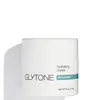What's inside
What's inside
 Key Ingredients
Key Ingredients

No key ingredients
 Benefits
Benefits

 Concerns
Concerns

 Ingredients Side-by-side
Ingredients Side-by-side

Water
Skin ConditioningButylene Glycol
HumectantDimethicone
EmollientCetearyl Alcohol
EmollientGlycol Stearate
EmollientGlycerin
HumectantMorus Alba Root Extract
BleachingArctostaphylos Uva Ursi Leaf Extract
Skin ConditioningGlycyrrhiza Glabra Root Extract
BleachingScutellaria Baicalensis Root Extract
AstringentCamellia Sinensis Leaf Extract
AntimicrobialSafflower Oil/Palm Oil Aminopropanediol Esters
Skin ConditioningKojic Acid
AntioxidantSodium Hyaluronate
HumectantSodium Polyacrylate
AbsorbentEthylhexyl Palmitate
EmollientCeteareth-20
CleansingPolysorbate 60
EmulsifyingAluminum Starch Octenylsuccinate
AbsorbentHydrogenated Polydecene
EmollientPPG-2 Myristyl Ether Propionate
EmollientPhenoxyethanol
PreservativeSqualane
EmollientCaprylic/Capric Triglyceride
MaskingGlycogen
HumectantCaprylyl Glycol
EmollientC12-15 Alkyl Lactate
EmollientEthylhexylglycerin
Skin ConditioningHexylene Glycol
EmulsifyingBisabolol
MaskingCitric Acid
BufferingPPG-5-Laureth-5
EmollientDisodium EDTA
Polyquaternium-11
Parfum
MaskingWater, Butylene Glycol, Dimethicone, Cetearyl Alcohol, Glycol Stearate, Glycerin, Morus Alba Root Extract, Arctostaphylos Uva Ursi Leaf Extract, Glycyrrhiza Glabra Root Extract, Scutellaria Baicalensis Root Extract, Camellia Sinensis Leaf Extract, Safflower Oil/Palm Oil Aminopropanediol Esters, Kojic Acid, Sodium Hyaluronate, Sodium Polyacrylate, Ethylhexyl Palmitate, Ceteareth-20, Polysorbate 60, Aluminum Starch Octenylsuccinate, Hydrogenated Polydecene, PPG-2 Myristyl Ether Propionate, Phenoxyethanol, Squalane, Caprylic/Capric Triglyceride, Glycogen, Caprylyl Glycol, C12-15 Alkyl Lactate, Ethylhexylglycerin, Hexylene Glycol, Bisabolol, Citric Acid, PPG-5-Laureth-5, Disodium EDTA, Polyquaternium-11, Parfum
Ingredients Explained
These ingredients are found in both products.
Ingredients higher up in an ingredient list are typically present in a larger amount.
Glycerin is already naturally found in your skin. It helps moisturize and protect your skin.
A study from 2016 found glycerin to be more effective as a humectant than AHAs and hyaluronic acid.
As a humectant, it helps the skin stay hydrated by pulling moisture to your skin. The low molecular weight of glycerin allows it to pull moisture into the deeper layers of your skin.
Hydrated skin improves your skin barrier; Your skin barrier helps protect against irritants and bacteria.
Glycerin has also been found to have antimicrobial and antiviral properties. Due to these properties, glycerin is often used in wound and burn treatments.
In cosmetics, glycerin is usually derived from plants such as soybean or palm. However, it can also be sourced from animals, such as tallow or animal fat.
This ingredient is organic, colorless, odorless, and non-toxic.
Glycerin is the name for this ingredient in American English. British English uses Glycerol/Glycerine.
Learn more about GlycerinWater. It's the most common cosmetic ingredient of all. You'll usually see it at the top of ingredient lists, meaning that it makes up the largest part of the product.
So why is it so popular? Water most often acts as a solvent - this means that it helps dissolve other ingredients into the formulation.
You'll also recognize water as that liquid we all need to stay alive. If you see this, drink a glass of water. Stay hydrated!
Learn more about Water